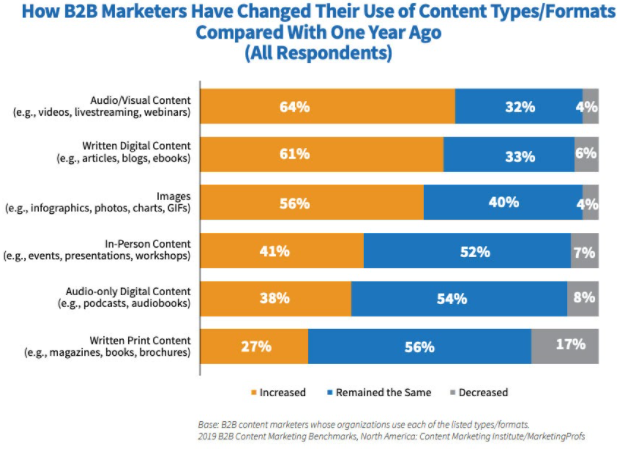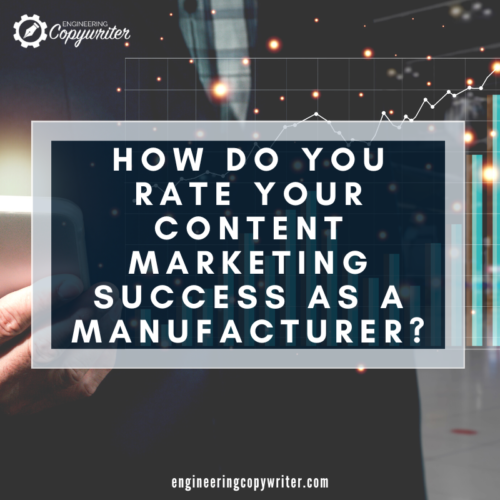Brochures are effective and inexpensive marketing tools used to advertise businesses’ products or services. They are widely used among different fields and organizations, and especially so in engineering. A study from Content Marketing Institute shows that 56% of marketers are still using written print content like an engineering brochure, compared with the previous year.

Image Source: Content Marketing Institute
An engineering brochure is a simple, eye-catching document that features and describes the technical aspects of products, services, infrastructures, and systems. It is an important marketing tool, as it provides buyers with critical information. A brochure is organized in such a way as to encourage engineers to explore specifications and compare data.
If you’re considering assembling a technical brochure, it’s worth noting the factors that make them unique. Below are seven points to keep in mind.
1. Product Descriptions
When writing a product brochure, don’t forget to include a clear description of what you are selling or doing. What do you want to highlight? Is it the product’s key feature? Is it a new technology? While this is a technical brochure, it doesn’t have to be boring. You should showcase not only your product’s features, but also focus on its benefits.
How can you show your products in a way that engineers will appreciate and which will help them in their purchasing decision? How can you present your product such that it will stand out from the competition? What makes you the right choice? Those are only some of the questions that must be answered while planning for your engineering brochure.
2. Benchmark your product
Demonstrate your superiority by benchmarking your product against a competitor or a known standard. Show your confidence by presenting case studies and research results. If it is a physical product, use pictures to show it off and make a more compelling case. You can also opt for a table to effectively present side-by-side comparisons of specifications and design features.
Think about your prospects and convey how your product or service can solve their problems. It also helps if you identify your competitive advantage beforehand and focus on that. This can help develop your brand message and image by relying on your key differentiators.
3. Front cover
The cover should be the most striking component of an engineering brochure. It tends to be the deciding factor in whether or not people reach for your brochure in the first place. Your communication starts with the cover, so don’t skimp on the quality or aesthetics.
Choose an eye-catching photo or graphic that showcases your offering. Relevant text that speaks directly to the reader should accompany the graphic to entice readers to flip to the next section of the brochure. Try also to highlight key benefits on the cover to further spark interest, but keep your text simple. Make it interesting and be creative.
4. Company name and logo
Among the purposes of any service or product, the brochure is to widen the prospects of your organization. Naturally, it is of great importance to include the company name and logo to sell the brand. Take this opportunity to highlight your company and your brand!
The company name and logo should be prominently displayed on the front and back covers if possible. These are also good places to impart the company’s philosophy with a tagline. Make sure it is short and catchy and representative of the product or service on offer.
5. Main text
This is the bulk of the relevant information on your product, service, or system. Features, descriptions, instructions, benefits, and/or stories should make up the core of your brochure, accompanied by relevant images and illustrations. Make it accurate and make sure the numbers and figures are laid out in a way that can be clearly understood. Challenge yourself to strike the right balance between detail and brevity – readers of engineering brochures expect to learn about your offering but don’t have time to read a novel.
It also helps to limit your fonts when designing your technical brochure. The more fonts you use, the more confusing your overall message will be. A good font resonates with your audience and helps engineers to identify your brand from a distance.
6. Sections and headers
Don’t overwhelm your reader with long paragraphs or walls of data. Different types of content and information need to be split into sections. Bold headers are used to separate sections, while subheadings, bullets, and text boxes can further delineate and organize the text. Breaking up the brochure into sections allows the readers to easily sort the flow of information. Make it easy on the eyes.
7. Pictures, charts, and graphs
Wordiness diminishes the overall appeal of the brochure. All good brochures include effective visual elements. Use pictures, charts, and graphs when possible rather than words. Engineers are visual and creative, so images often make better representations for your product and or services.
Relevant high-quality images catch the reader’s attention and give an impression of the brand’s commitment to quality. Invest in quality photos of your product. Prospects will then be more enticed to buy what you’re advertising. Likewise, charts and graphs help readers digest information easier than lengthy blocks of text. Just remember that simplicity is important.
8. Contact information
Contact information is critical to your brochure since, without it, prospects can’t reach the company and become paying customers. In the end, that’s the purpose of the brochure. Apart from the company name, it should include an address, phone number, email address, and website. Make sure it’s readable and easy to find.
When you have included the above items on your technical brochure, don’t forget to include your Call-To-Action. Let your engineering readers know exactly what action you’d like them to do after reading through your printed content. This will help them remember your brand when the time comes.
If you need help with the copy for your technical brochures – get in touch today.






